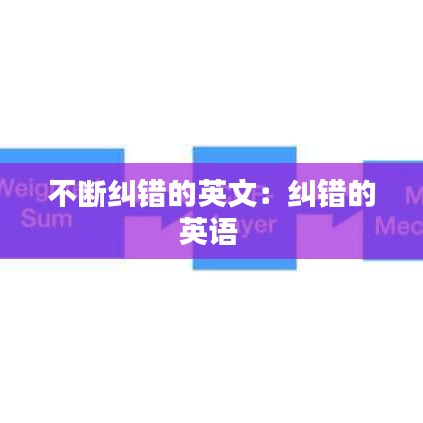Introduction to the Concept of Continuous Error Correction
In the journey of human progress and development, the ability to continuously correct errors is a fundamental trait that has led to innovation and advancement. Whether it's in science, technology, or everyday life, the process of identifying and rectifying mistakes is crucial for growth and improvement. This article delves into the importance of continuous error correction and explores its applications in various domains.
The Importance of Continuous Error Correction in Learning
Learning is an iterative process that involves making mistakes and learning from them. Children, for instance, learn to walk by falling and getting back up. Similarly, adults learn new skills and knowledge by continuously correcting their errors. The ability to self-correct mistakes is essential for effective learning, as it allows individuals to refine their understanding and improve their performance over time.
Education systems worldwide emphasize the importance of making mistakes as a stepping stone to success. Teachers encourage students to embrace their errors as opportunities for growth, rather than viewing them as setbacks. By fostering a culture of continuous error correction, educational institutions equip students with the resilience and adaptability needed to thrive in a dynamic world.
Continuous Error Correction in Technology and Innovation
In the realm of technology and innovation, continuous error correction is vital for the development of robust and reliable systems. Software developers, for instance, rigorously test their products to identify and fix bugs. This process ensures that the end-user experience is seamless and error-free, thereby enhancing user satisfaction and trust in the product.
Artificial intelligence and machine learning algorithms also rely on continuous error correction to improve their accuracy and efficiency. By analyzing data and learning from past mistakes, these systems can evolve and adapt to new challenges. This iterative process is crucial for the advancement of technologies that are increasingly integrated into our daily lives, such as autonomous vehicles, healthcare diagnostics, and financial services.
Continuous Error Correction in Business and Management
In the business world, continuous error correction is essential for maintaining competitive advantage and ensuring long-term success. Companies that fail to address their mistakes and learn from them risk falling behind their competitors. Effective management practices involve regularly reviewing performance, identifying areas of improvement, and implementing strategies to correct errors.
Lean manufacturing principles, for example, emphasize the importance of continuous improvement and error correction. By adopting a culture of "kaizen," businesses can systematically identify and eliminate waste, reduce defects, and enhance productivity. Similarly, project management methodologies like Agile encourage teams to embrace change and adapt to errors as they arise, ensuring the successful completion of projects.
Continuous Error Correction in Personal Development
On a personal level, continuous error correction is key to personal growth and self-improvement. By reflecting on our actions and decisions, we can identify areas where we can do better and take steps to correct our mistakes. This process involves self-awareness, self-reflection, and the willingness to learn from past experiences.
Developing a growth mindset, as advocated by psychologist Carol Dweck, is crucial for embracing continuous error correction. Individuals with a growth mindset believe that their abilities can be developed through dedication and hard work, making them more open to feedback and willing to learn from their errors.
Challenges and Strategies for Continuous Error Correction
While the concept of continuous error correction is beneficial, it's not without its challenges. One of the primary challenges is the psychological barrier of accepting and acknowledging our mistakes. Many people struggle with the fear of failure and the negative emotions associated with making errors.
Overcoming these challenges requires a proactive approach. Strategies such as setting realistic goals, seeking feedback, and celebrating small victories can help individuals develop a more positive attitude towards error correction. Additionally, creating a supportive environment where mistakes are viewed as opportunities for learning can encourage individuals to embrace continuous improvement.
Conclusion
In conclusion, continuous error correction is a crucial aspect of human progress and development. From learning and education to technology, business, and personal growth, the ability to identify and rectify mistakes is essential for achieving success and staying competitive. By fostering a culture of continuous improvement and embracing the learning opportunities that errors present, individuals and organizations can pave the way for a brighter future.
转载请注明来自河南省豫芊香食品有限公司,本文标题:《不断纠错的英文:纠错的英语 》










 豫ICP备2020036209号-1
豫ICP备2020036209号-1
还没有评论,来说两句吧...